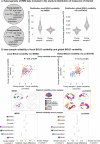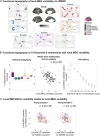This is a preprint.
The biological role of local and global fMRI BOLD signal variability in human brain organization
- PMID: 37961684
- PMCID: PMC10634715
- DOI: 10.1101/2023.10.22.563476
The biological role of local and global fMRI BOLD signal variability in human brain organization
Abstract
Variability drives the organization and behavior of complex systems, including the human brain. Understanding the variability of brain signals is thus necessary to broaden our window into brain function and behavior. Few empirical investigations of macroscale brain signal variability have yet been undertaken, given the difficulty in separating biological sources of variance from artefactual noise. Here, we characterize the temporal variability of the most predominant macroscale brain signal, the fMRI BOLD signal, and systematically investigate its statistical, topographical and neurobiological properties. We contrast fMRI acquisition protocols, and integrate across histology, microstructure, transcriptomics, neurotransmitter receptor and metabolic data, fMRI static connectivity, and empirical and simulated magnetoencephalography data. We show that BOLD signal variability represents a spatially heterogeneous, central property of multi-scale multi-modal brain organization, distinct from noise. Our work establishes the biological relevance of BOLD signal variability and provides a lens on brain stochasticity across spatial and temporal scales.
Figures







References
-
- Lewontin R. C. The Units of Selection. Ann Rev Ecol Syst, 1(1), 1–18 (1970).
-
- Barsugli J. J. & Battisti D. S. The Basic Effects of Atmosphere–Ocean Thermal Coupling on Midlatitude Variability*. J. Atmos. Sci. 55, 477–493 (1998).
-
- Rajendra Acharya U., Paul Joseph K., Kannathal N., Lim C. M. & Suri J. S. Heart rate variability: a review. Med Bio Eng Comput 44, 1031–1051 (2006). - PubMed
-
- Meena C. et al. Emergent stability in complex network dynamics. Nat. Phys. (2023) doi:10.1038/s41567-023-02020-8. - DOI
Publication types
Grants and funding
LinkOut - more resources
Full Text Sources
